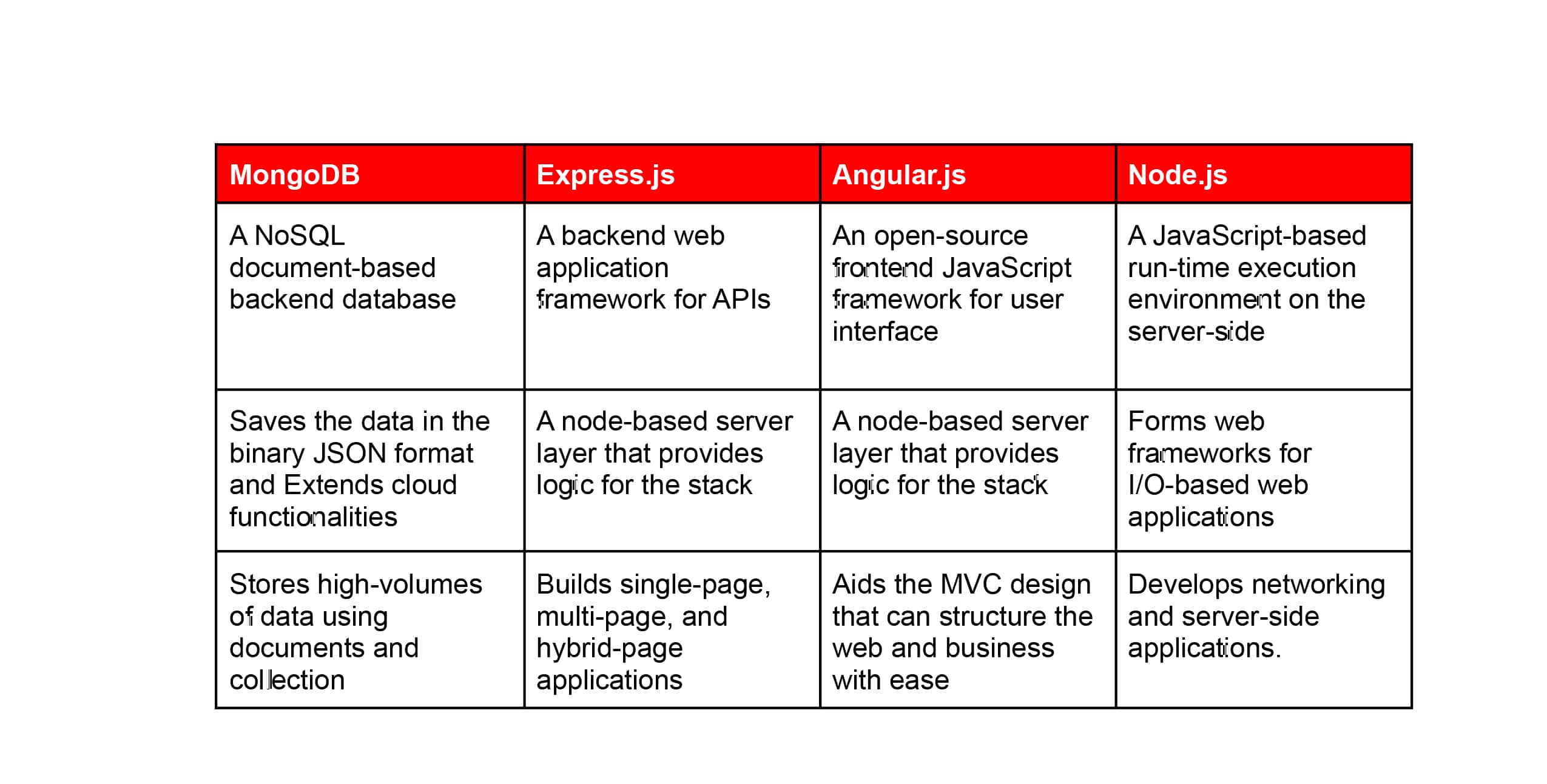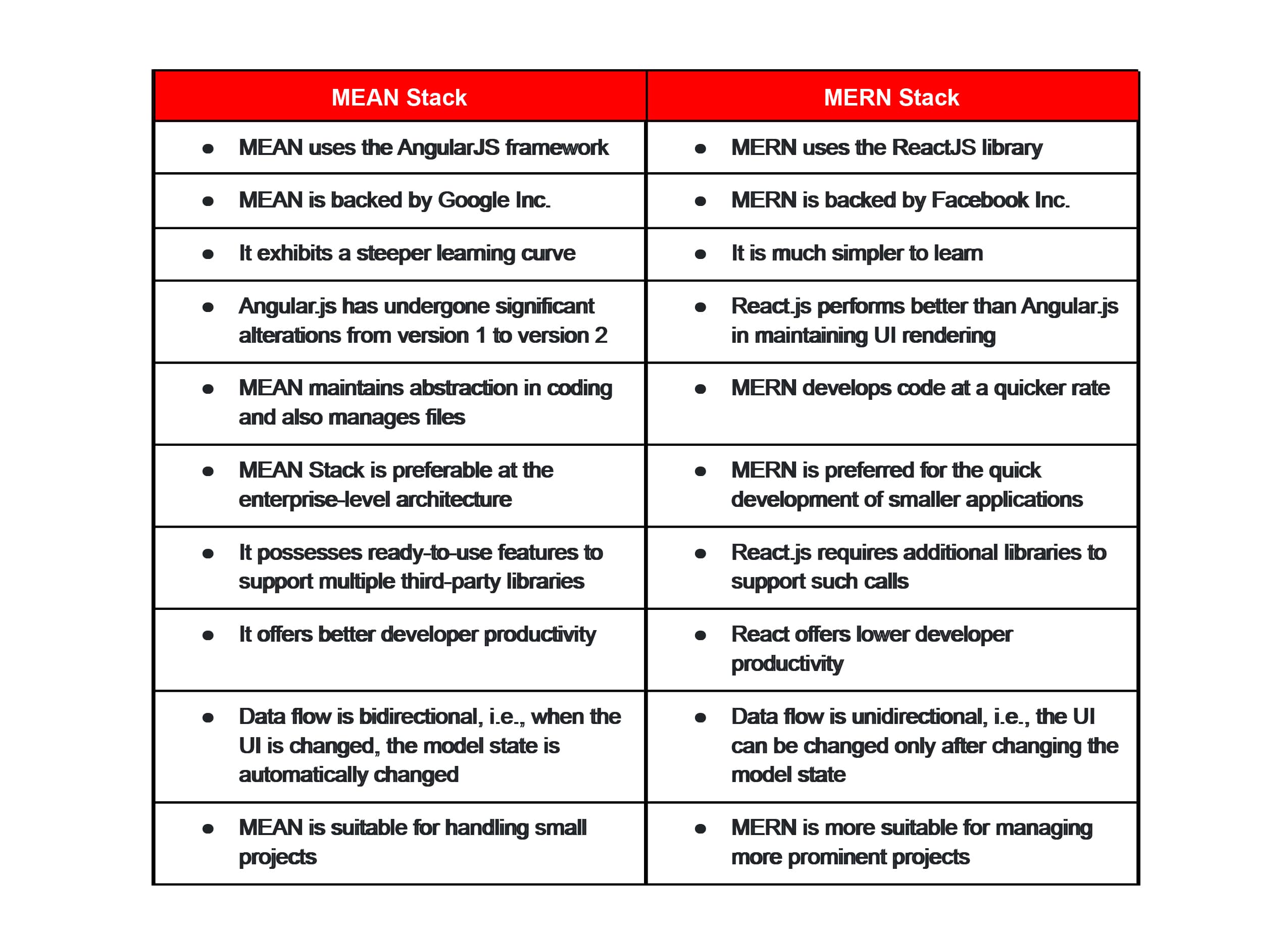Application stack development has taken another new level in the last decade. Each web platform we see on the Internet has two sides: The front-end, a visualization of data that the user sees, comprises web design and its interface. The backend operates in the background to manage the data seen by the user on the front-end. The backend consists of server-side programming and the database. The tech stack, on the other side, indulges in a pool of tools and frameworks to create well-operational software.
In this blog, let’s discuss two widely used technology stacks and their differences.
-
MEAN Stack
MEAN Stack is a contemporary approach to Web Development. It can be titled as a collection of JavaScript-based Web Development technologies that help build solid websites and apps. MEAN is a free, open-source JavaScript framework with a comprehensive suite of built-in testing tools.
MEAN is a short form for MongoDB, Express.js, Angular.js, and Node.js. Let us now have a look at each one of them:
– MongoDB
– Express.js
– Angular.js
– Node.js
Advantages of Hiring a MEAN Stack Developer
A MEAN Stack Developer is appropriate for expediting the web or mobile app development process. The following are the benefits of hiring a MEAN Stack Developer:
– MEAN Stack Developers cover the entire development process from the front-end (client-side) to an application’s backend (server-side) using JavaScript.
– They incorporate MVC architecture and lessen the hefty work, smoothing out the development process.
– They work with prime technologies, i.e., they utilize MongoDB and Express.js to work on the back-end, whereas Angular.js and Node.js work on the front-end.
- They use the framework in such a manner that it empowers popular plugins and lessens the time taken for system administration.
Skill Sets a MEAN Stack Developer Must Possess:
– Ample knowledge of cloud technologies, structure, web designing, and integration.
– Understanding of HTML and CSS
– Knowledge of SDLC and the Agile environment
– Have access to various frameworks for web creation and its development
Why Choose MEAN Stack?
MEAN Stack is highly flexible toward code transfer within other frameworks. Using this stack, one can quickly build a robust framework that supports their daily requirements. MEAN Stack is simple and easy to use and learn with good community support. It is preferred for small-to-medium-scale projects.
It extends over a complete development cycle from the client to the server. However, the MEAN stack is ideal for robust front-end development, ideally for enterprises that require single-page applications but with a dynamic user interface.
2. MERN Stack
MERN Stack is a common substitute to MEAN Stack, where conventional Angular.js is replaced by React.js, which makes the whole development process much more smoother and more accessible.
‘MERN’ is an acronym comprised of a set of technologies, namely MongoDB, Express.js, React.js, and Node.js. Let’s understand what each of these components does:
– MongoDB: is a cross-platform, document-oriented scalable NoSQL database. It is a flexible platform that allows users to design tables, schemas, and more. Once MongoDB is installed, it functions along with Mongo Shell, a JavaScript interface that performs the querying, updates, and deletes records.
– Express.js: This is layered on top of NodeJS. It backs the backend framework and makes it easier to write the backend code. It assists in designing better APIs and web applications. This modern framework also supports middleware and promotes code reusability to ease the code’s writing process. It is specially designed to manage simplified applications.
– React.js: It is a front-end framework used for developing user interfaces. It quickly handles changing data, streamlining the development of single-page and mobile applications. This JavaScript library lets coders develop UI components and the interface of single-page web applications. It also allows them to edit and refresh the page without reloading it.
– Node.js: It is a JavaScript run-time environment that lets users to run the code on the server. It supports Node Pack Manager (npm), an amalgamation of hundreds of public and private node modules that are free to use and download.
Advantages of Hiring a MERN Stack Developer
MERN Stack Developers can effectively build web and mobile applications using standard processes and abilities. Below are a few add-ons on why you should hire a MERN Stack Developer.
– MERN Stack Developers execute design thinking with improved proficiency in multiple technologies.
– They preserve full-fledged development in the shortest run-time.
– They concentrate on brainstorming solutions by maintaining an engaging user experience and delivering highly scalable cloud integration.
Skill Sets a MERN Stack Developer Must Possess
– Be skilled in HTML and JavaScript
– Knowledge of profiling applications and optimizing them
– Understanding of various databases and programming templates.
Why choose MERN Stack?
In contrast to Angular.js of the MEAN Stack, MERN Stack’s React.js is the best for UI layer abstraction. It implements code development quickly due to its diverse user interfaces within the library. MERN acts the best in managing and updating extensive dynamic JSON data that can swiftly sail between the front end and back end.
MEAN Stack vs. MERN Stack
Now that you are familiar with MEAN Stack and MERN Stack, let’s come to the main topic of discussion: MEAN vs. MERN. The presentation of their structure will let you delve into the significant differences between MEAN and MERN.
In MEAN and MERN, all of the above elements are combined to build a full-stack project. They provide opportunities for JavaScript programmers to develop full-stack applications with an engaging interface for users to interact with, which allows the users to navigate through pages and respond to actions quickly.
Difference Between MEAN Stack and MERN Stack
Points to Consider Before Choosing the Right Stack for Your Business
Project needs: Scrutinize project needs to check the usefulness of Stack
New practices: Initiate Agile development approaches to experience a customer-driven market
Flexibility and feasibility: Observe the differences between database architecture and software solutions to record flexibility
Cost of development: Identify various cost-effective strategies for the whole development process.
Conclusion
Provided the broad ambit of available technology stacks, MEAN Stack and MERN Stack furnishes you with the same functionalities in their work. MEAN and MERN have become equally significant in managing their roles in the modern application development market. They are proliferating in popularity as an intrinsic part of Full Stack Development. Both MEAN and MERN are secure frameworks. However, they differ in their architectural placement.











